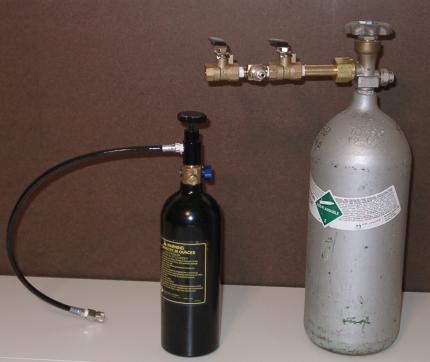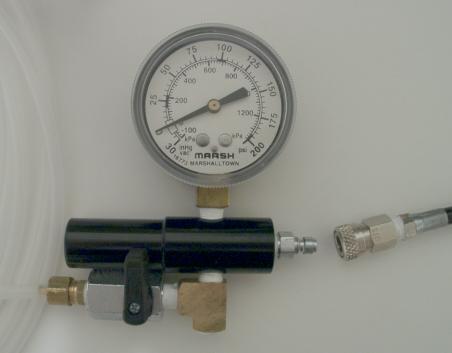Thank the paintball people
Thanks to the popularity of the sport of paintball, there are a number of companies that manufacture and sell comparatively inexpensive portable tanks, regulators, and fittings for compressed carbon dioxide or air.
I put together a system for filling water rockets. I describe the system below, to give people an idea what is required to get a portable CO2-tank system up and running.
Parts list
I bought
- A 5-pound CO2 tank with valve, cost US$75 at a local welding-supply store. It holds 5 pounds of liquified CO2—the steel tank obviously weighs more than this. Refills at welding-supply stores cost about US$20. Most places swap your empty cylinder with a filled cylinder of the same size, since the actual refilling takes place at a centralized facility. Refills for 20-pound cylinders cost about the same, so over the long term you save money with a bigger tank even though you pay more initially.
- A 20-ounce paintball CO2 tank with valve, cost US$30 on ebay.com. I also bought a “fill station” on ebay for about US$25. The fill station is basically a few fittings that allow you to connect a paintball tank (CGA 320 threads) to a standard CO2 cylinder in order to refill the small tank.
- A “Stabilizer” adjustable pressure regulator, cost US$74 by on-line order from Palmer’s Pursuit Shop. I bought the side-line low-pressure version (up to 300 psi output). For an additional US$26 I also got a set of quick-disconnect fittings, an inline on/off valve, and a brass T-connection. Like a lot of paintball equipment, the regulator connections and other fittings are based on 1/8-inch NPT pipe threads used in the United States.
- A large-face 200-psi pressure gauge with 1/8-inch NPT nipple, cost US$10 on ebay.com. This was installed on the extra port of the pressure regulator.
- Miscellaneous: 1/4-inch polypropylene tubing, compression fittings, and teflon pipe tape purchased at the local hardware store. The tubing is used for a delivery line so I can pressurize rockets from a safe distance.
Pictures
Shown below are the small and big CO2 tanks. Attached to the big tank is the fill station. I changed it so that the small tank connects to the filling station or to the pressure regulator with a quick-release fitting. The main trick for getting the liquid CO2 to transfer from the big tank to the small tank is to make sure the small tank is colder than the big tank. You can do this by exhausting gas from the small tank into the atmosphere, which cools the tank down. My own invention is instead to put the small tank in the freezer for 30 minutes before filling it. If the big tank does not contain a siphon tube, then it must be inverted to get the liquid out. My fill station came with instructions and safety information.

Below is a close-up picture of the regulator (the black cylinder-thing). Pressure is adjusted using a hex wrench inserted in the left side. Palmer's Pursuit Shop sells an adjustment knob that permanently attaches to the regulator, if desired. I installed an on-off valve leading to the delivery line. I fill rockets by turning the valve on and off while leaving the regulator at a set pressure.

The cut-off end of a bicycle pump is attached with a hose clamp to the end of the delivery line.

